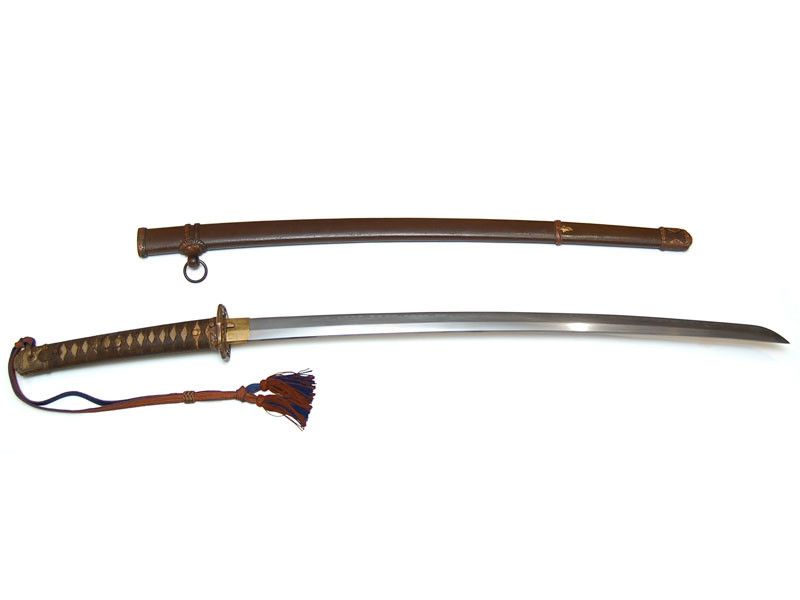




More informations about this product
| Total Weight | 1.669 kg | |
| Weight without Saya | 1.069 kg | |
| Blade Weight | 0.696 kg | |
| Full length Naked Blade (Toshin) |
84.8 cm | |
| Nagasa | 66.2 cm | |
| Tsuka Length | 25.5 cm | |
| Sori (curvature) | 1.6 cm | |
| Kissaki Length | 3.8 cm | |
| Moto Haba | 3.12 cm | |
| Saki Haba | 2.15 cm | |
| Moto Kasane | A= 0.63 cm B = 0.70 cm |
|
| Saki Kasane | A= 0.52 cm B = 0.55 cm |
|
| Curvature | Tori-zori | |
| Type Kissaki | Chū Kissaki (Medium length) | |
| Blade Structure | Shinogi zukuri (diamond shaped) | |
| Mune | Iori mune (Triangular) | |
| Hamon | Kata ochi Gunome with the beginning in Yakidashi (Gunome with pikes in Sanbon Sugi type). Start of the quenching line in Suguha. | |
| Hada | Very tight Ko Mokume nearly Muji | |
| Boshi | O Maru (return with a large rounding) | |
| Nakago | Ubu, 1 Mekugi Ana, “Ichimonji Gata” shape (Futsu Gata), ending in 'Ha Agari Kuriji' (Sissymetrical U), Yasurime ‘Taka No Ha’ (falcon feather, in chevrons). Signed Omote Mei : 関住福田兼丈作 “Sekiju Fukuda Kanetake Saku” |
|
| Saya | 604g , Gunto Saya Type 98, lacquered Chairo Ishime (Matte brown), Inside in Magnolia with a steel shell, Gunto Mounting with Ishizuki, Semegane with motives of gilded Kashiwa leaves, Ashi with Obi-Tori, Koiguchi in copper (or Kuchigane). Steel with drawings of Sakura leaves and flowers. One has to note that the Kuchigaen and Ishizuki are screwed on the steel shell of the saya. | |
| Tsuka & Tosogu (Tsuba, Menuki, Fuchi Kashira) |
- Tsuka : 182g, 25.5cm (with Kabutogane), Moro hineri maki braiding in brown silk, white same. - Seppa : Double Seppa mounting numbered ‘82’.2 serrated seppa (13g) in gilded copper, 2 Seppa quadrilobed (18g) with Inome drawing (wild boar eye). The Inome drawing is also called Aoi Ha (Aoi leaves), it shows Asarum Ginger leaves, emblem of the Tokugawa Clan. - Habaki :25g, in copper, with vertical fine and little deep lines. - Fuchi Kashira :Fuchi numbered ‘82’ with Sakura flowers and leaves design, with Saya locking mechanism, push-button with a Sakura flower design. Kabutogane type Kashira, with Sakura flowers and leaves design, with an eyelet (Hatome) for the wrist strap. - Tsuba :125 g,5.83 cm x 7.01cm x 0.5 cm,numbered ‘82’, with 4 embossed Sakura on each surface, and embossed Seppa-Dai wo the shape of the quadrilobed Seppa. Rims in Sukidashi, Aoi Gata shaped (quadrilobed in the shape of Ginger Asarum leaves). - Menuki :2 Menuki yellow copper with three 10 petals Sakura flowers design. - Wrist strap: bicolored silk, brown and blue. This kind of wrist-strap was designed for senior officers, Lieutenants or Captains. |
|
| Study & Team Review |
Study : Traditionnal Gendaito in Gunto type 98 mounting, made for the Japanese army during World War II (1939-1945). Thes swordsmith Kanetake, civil name Fukuda Jōtarō ‘福田丈太郎’, did lived in Seki (Gifu). He was born in 1926, and died 1989. He worked for the Gunto smithing of Seki and did signed as « Seki Ju Fukuda Kanetake Saku » 関住福田兼丈作. These Seki Swordsmiths were listed in the register "Seki Tanrensho". His named was also found in the "Seki Kaji Tosho" list, with a little over 200 other swordsmiths. The 98 type mounting (九八式軍刀) could be found starting from 1938. It is an evolution of the 94 mounting type, with only one Bélière. The 98 mounting type had many evolutions with the time, being poorer and poorer by the lack of raw materials. This mounting is a very good quality and comes from the early editions. Team Review : It is quite rare to find a Gunto especially in such a good quality and good shape, as we have here. The mounting and the blade are in a very good general shape. The 98 type mounting is a full set, numbered '82', no restoration to be planned. The blade is also very fairly conserved, juste a few openings points in the steel, from the very small air bubbles during the smithing. The start of the quenching with the Yakidashi reminds of the Osaka quenching kind, and the Gunome with the pikes, reminds of the Kanemoto lineage of Seki. The general balance is very nice, as is the conservation state. A last point to be noted, is the link between the birth date of this Kanetake swordsmith et the making of the blade in the beginning of the war, approx. 1940.. He was already smithing for the Japanese army aged of 14, which lets presume an early apprenticeship, and exceptionnal capacities in swordsmithing. |
|
Share your opinion
error Your review appreciation cannot be sent
feedback Report comment
check_circle Report sent
error Your report cannot be sent